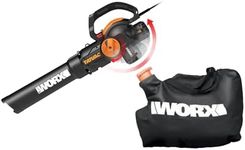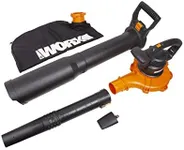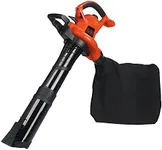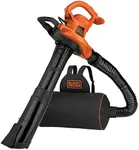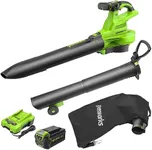Buying Guide for the Best Leaf Blower Vacuums
Choosing the right leaf blower vacuum can make yard work much easier and more efficient. When selecting a leaf blower vacuum, it's important to consider various specifications to ensure you get a model that fits your needs. Here are some key specs to look at and how to navigate them.Power SourceLeaf blower vacuums can be powered by electricity, batteries, or gas. Electric models are typically lighter and quieter, making them ideal for small yards and quick cleanups. Battery-powered models offer more mobility without the hassle of cords but may have limited run time. Gas-powered models are the most powerful and suitable for large areas or heavy-duty tasks but can be noisy and require more maintenance. Choose based on the size of your yard and the intensity of the work you need to do.
Air SpeedAir speed, measured in miles per hour (MPH), indicates how fast the air is moving out of the blower. Higher air speeds can move heavier debris and cover larger areas more quickly. For light tasks like clearing grass clippings or dry leaves, lower air speeds (up to 150 MPH) are sufficient. For heavier debris like wet leaves or small twigs, higher air speeds (150-250 MPH) are more effective. Consider the type of debris you typically deal with when choosing the air speed.
Air VolumeAir volume, measured in cubic feet per minute (CFM), indicates how much air the blower can move. Higher CFM values mean the blower can cover more area in less time. For small yards or light debris, a lower CFM (up to 300 CFM) is adequate. For larger yards or heavy debris, higher CFM (300-600 CFM) is more suitable. Match the CFM to the size of your yard and the amount of debris you need to clear.
WeightThe weight of the leaf blower vacuum affects how easy it is to handle and maneuver. Lighter models (up to 8 pounds) are easier to carry and use for extended periods, making them ideal for small tasks or users with limited strength. Heavier models (8-15 pounds) may offer more power but can be tiring to use for long durations. Consider your physical strength and the duration of your typical yard work when choosing the weight.
Noise LevelNoise level, measured in decibels (dB), indicates how loud the leaf blower vacuum is during operation. Quieter models (up to 70 dB) are better for residential areas and reduce noise pollution. Louder models (70-100 dB) may be more powerful but can be disruptive to neighbors and require hearing protection. If you live in a quiet neighborhood or prefer a less noisy operation, opt for a model with a lower noise level.
Mulching RatioThe mulching ratio indicates how effectively the leaf blower vacuum can reduce the volume of collected debris. A higher mulching ratio (up to 16:1) means the vacuum can compress more leaves into a smaller space, making disposal easier and reducing the number of bags needed. If you have a lot of leaves to collect and want to minimize waste, choose a model with a higher mulching ratio.
Ease of UseEase of use encompasses features like ergonomic handles, adjustable speeds, and easy conversion between blower and vacuum modes. Models with user-friendly features are more comfortable to operate and can make yard work less strenuous. If you prioritize convenience and comfort, look for models with features that enhance ease of use.
